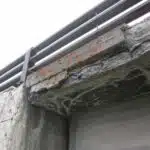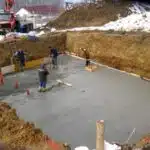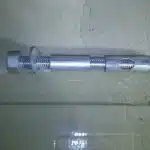Driving nails into concrete by hand can be a daunting task for many construction carpenters. The process requires the use of specialized tools and techniques that require careful consideration to ensure successful completion of the task. Whether you are working on a small home renovation project or a large-scale commercial construction job, knowing how to drive nails into concrete by hand is an essential skill that every carpenter should master.
Driving nails into concrete by hand involves a combination of strength, precision, and patience. The process requires the use of specific types of hammers and nails, as well as knowledge of proper nail placement and technique. As a construction carpenter, understanding the right approach to driving nails into concrete can save you time and money, while also ensuring your work is safe and secure for those who will be using it. In this article, we will explore some tips and tricks for successfully driving nails into concrete by hand, helping you to become more efficient in your work while serving others with excellence.
Understanding The Different Types Of Concrete
The world of construction is vast and varied, with many different types of concrete available for use. As a carpenter, it’s essential to understand the various types of concrete finishes and their uses. Whether you’re working on a residential or commercial project, it’s crucial to know the specific type of concrete you’ll be working with to ensure that your structure is strong and long-lasting.
One of the first things to consider when working with concrete is whether or not it has been reinforced. Concrete reinforcement methods involve adding reinforcing materials such as steel bars, mesh, or fiber to the mix to increase its strength and durability. Reinforced concrete is commonly used in high-rise buildings, bridges, tunnels, and other structures where strength and stability are paramount.
Another factor to consider when choosing the right type of concrete for your project is the finish. There are many different types of concrete finishes available, each with its unique texture and visual appeal. Some popular options include polished concrete, stamped concrete, exposed aggregate, and acid-stained concrete. By understanding these different types of finishes and their uses, you’ll be able to choose the right one for your project and create a finished product that both looks great and stands up to wear and tear over time.
Choosing The Right Nails For The Job
Different sizes and materials of concrete nails are available for different construction purposes. The size of the nail to use depends on the thickness and density of the concrete surface. Large nails are suitable for thicker surfaces, while smaller ones work well on less dense surfaces. The right material to choose is also important, as it affects the holding power of the nail. Common materials used for concrete nails include hardened steel, stainless steel, and galvanized steel.
When choosing the right nails for a job, several factors need to be considered. The first factor is the type of project being undertaken; commercial or residential projects may require different types of nails based on their specific requirements. The second factor is the type of tool that will be used to drive in the nail; some tools work best with certain types of nails than others. Additionally, it’s essential to consider how much weight or pressure will be placed on the nail once it’s installed.
In summary, choosing the right nails for a concrete project can make a significant difference in its overall success. It’s crucial to select appropriate sizes and materials based on factors such as surface density and weight-bearing requirements. With these factors in mind, one can select suitable nails that provide optimal holding power for their specific construction needs. Moving forward into preparing the concrete surface requires careful considerations as well.
Preparing The Concrete Surface
Before driving nails into concrete, it is important to prepare the surface properly. Surface preparation techniques vary depending on the type of concrete and its condition. The first step in preparing the surface is to remove any loose debris, such as dirt or dust, from the area where you plan to drive the nail. This can be done with a stiff bristle brush or a vacuum.
Next, it is important to ensure that the concrete surface is completely dry. Moisture can prevent nails from being driven in effectively and can also cause rusting over time. Importance of moisture control cannot be overstated when working with concrete surfaces. To test for moisture, place a small piece of plastic wrap on the surface and seal it down with tape. Wait 24 hours before checking for any signs of condensation under the plastic.
Finally, after removing all debris and ensuring that your surface is dry, you can proceed with applying adhesive if necessary or marking the spot where you plan to drive your nail. It may be helpful to use a chalk line or straight edge to ensure that your placement is straight and accurate. By taking these steps in preparing your concrete surface, you can better ensure successful nail placement without damaging your tools or materials.
Tips for Preparing Concrete Surface
- Use a stiff bristle brush or vacuum to remove loose debris from the concrete surface.
- Check for moisture by placing plastic wrap on the surface and sealing it down with tape.
- Ensure proper moisture control by allowing sufficient time for drying before proceeding with nail placement.
With these tips in mind, you can prepare your concrete surface effectively for driving nails by hand without causing damage to your tools or materials. Now that we have covered preparation techniques, let’s move onto marking the spot for nail placement and ensuring accuracy in our next section.
Marking The Spot For Nail Placement
- When hammering nails into concrete, it is important to begin by measuring and marking the spot for the nail.
- Use a ruler or measuring tape to measure and mark the desired size and depth of the nail.
- Mark the spot for the nail using a pencil or other writing utensil.
- Use a hammer to create a small indentation in the concrete at the marked spot.
- Hammer the nail into the indentation and tap it further with a ball-peen hammer until it is securely in place.
- An alternative method is to use a hammer drill, which creates a hole in the concrete and allows the nail to be easily inserted.
Measuring The Spot
As a construction carpenter, marking the spot for nail placement is crucial to ensure that the structure will remain sturdy and secure. Before driving nails into concrete by hand, it is important to measure the spot accurately. This involves using a measuring tool such as a tape measure or ruler to determine the precise location of where the nail needs to be driven.
In addition to measuring the spot, calculating depth is also essential. The depth of the hole determines how much of the nail will be embedded in the concrete, which affects its holding power. To calculate depth, use a drill bit that is slightly smaller than the diameter of the nail and drill into the concrete until it reaches the desired depth. This will ensure that there is enough space for the nail to be inserted without cracking or damaging the concrete.
Overall, measuring and calculating depth are crucial steps in marking the spot for nail placement when driving nails into concrete by hand. By taking these precautions, you can ensure that your work will be efficient and effective while maintaining safety standards on site. Remember to always use proper tools and techniques when working with concrete to avoid injury or damage to property.
Marking The Spot
Marking the spot for nail placement is a crucial step in ensuring the stability and durability of any construction project. As a construction carpenter, choosing the right marker for concrete is essential to accurately marking the spot. The most commonly used markers are chalk, pencil, and paint. Chalk works well for temporary markings but can easily rub off or be washed away by rain. Pencil markings are more permanent but may not show up as clearly on darker concrete surfaces. Paint markers are highly visible and long-lasting but can be difficult to remove once dry.
Accurately measuring the placement of nails in concrete is equally important when marking the spot. A tape measure or ruler is typically used to determine the precise location where the nail needs to be driven. When measuring, it’s important to take into account any obstructions or other factors that may affect nail placement, such as pipes or wiring behind walls. Measuring twice before driving a nail can prevent costly mistakes and ensure that everything lines up correctly.
In addition to measuring accurately, it’s also important to mark the depth of the hole where the nail will be inserted. This ensures that there is enough space for the nail to be securely embedded in the concrete without causing damage or cracking. Using a drill bit slightly smaller than the diameter of the nail and drilling into the concrete until it reaches the desired depth will provide ample space for proper insertion. By taking these precautions when marking spots for nail placement in concrete, you can ensure that your work will be efficient, effective, and safe on site.
Hammering The Spot
Ensuring the stability and durability of any construction project requires a meticulous process, especially when it comes to marking the spot for nail placement. In line with this, carpenters must also know how to hammer the spot properly to prevent any damage or accidents on site. This subtopic is crucial in finishing a successful construction project.
As a construction carpenter, one must learn the proper grip when using a hammer. The grip should be firm but not too tight to avoid discomfort or hand fatigue. Additionally, the wrist should be kept straight while holding the hammer handle to ensure precision and accuracy in hammering. Proper grip is essential in maintaining control over the tool and preventing mishaps during work.
Aside from having a proper grip, having good hammering technique is equally important. When hammering nails into concrete, it’s best to use short strokes instead of longer ones to avoid cracking or damaging the surface. It’s also crucial to maintain a consistent angle when driving nails into concrete to prevent them from bending or getting stuck halfway through. By practicing good hammering techniques, carpenters can ensure that they will achieve their desired results while keeping themselves and others safe on site.
Using A Masonry Bit To Make A Hole In The Concrete
After marking the spot for nail placement, the next step in driving nails into concrete is to use a masonry bit to make a hole in the concrete. While it may be tempting to simply try to hammer a nail directly into the concrete, this will likely result in a broken nail and frustration. Masonry bits are designed specifically for drilling holes in materials such as concrete, brick, and stone.
One of the benefits of using masonry bits is that they are made from harder and more durable materials than standard drill bits. This allows them to withstand the tough conditions presented by drilling into hard surfaces like concrete. Proper technique for drilling with a masonry bit involves using a slow speed and steady pressure while maintaining control of the drill. It is important to allow the bit to do most of the work; pushing too hard can cause overheating and damage to both the bit and drill.
In order to properly insert the nail into the hole created by the masonry bit, it is important that you choose an appropriately sized nail for your project. The diameter of your nail should not exceed that of the hole, as this will result in difficulty inserting or even breaking off the nail. Once you have chosen your nail, gently tap it into place using a hammer until it is flush with the surface of the concrete. With proper technique, you can confidently drive nails into concrete by hand without causing damage or undue frustration.
Inserting The Nail Into The Hole
Inserting nails into concrete can be a tough job, but with the right tools and techniques, it can be done effectively. Different types of nails are available for various applications, and choosing the appropriate one is crucial to ensure that the nail stays in place. Commonly used concrete nails include hardened steel nails and masonry nails, which come in different lengths and thicknesses.
Before inserting the nail, it is essential to take safety precautions. Wearing protective gear such as gloves, eye goggles, and earplugs is vital to prevent injuries from flying debris or loud noise. Additionally, ensure that the surface you are working on is stable and secure to avoid accidents.
Once you have selected the right nail for your job and taken safety precautions, you can insert the nail into the hole. Start by positioning your hand on top of the nail head and using a hammer to drive it into place gently. It’s important not to hit too hard as this may cause the nail to bend or break. Instead, tap gently until it goes in flush with the surface of the material being nailed. Proper insertion ensures that your work stays secure for a long time.
Transition: To ensure maximum effectiveness when driving nails into concrete surfaces by hand, positioning them at the correct angle is crucial.
Positioning The Nail At The Correct Angle
To drive a nail into concrete, proper hammering technique is crucial. The first step is to position the nail at the correct angle and insert it into the pre-drilled hole. Once the nail is in place, ensure that it is straight and not bending.
To achieve proper hammering, use a heavy-duty hammer with a flat surface on one end. Hold the hammer close to the end of its handle to maximize control and accuracy. Begin tapping the nail gently with light blows to set it in place, gradually increasing the force of each blow until it has been driven all the way in.
Avoid bending the nail by ensuring that it stays straight while being hammered. If you notice that it is starting to bend, stop and reposition it before continuing. When finished, inspect your work to confirm that the nail has been completely driven into place without any visible deformation or damage.
- Use a high-quality hammer specifically designed for concrete.
- Take care when positioning and aligning the nail.
- Hammer gently at first, gradually increasing force.
- Check for signs of bending or damage as you work.
- Inspect your finished work carefully.
With these tips in mind, you can confidently drive nails into concrete by hand using proper technique and tools. In order to secure your project correctly, remember that proper hammering technique is essential for avoiding mistakes such as bent nails or uneven surfaces. By following these guidelines closely, you can achieve professional-quality results every time you work with concrete materials.
Tapping The Nail With A Hammer To Set It In Place
- Working with concrete and a hammer always poses a safety risk, so it is important to take precautions to ensure that the job is done safely.
- When driving nails into concrete it is best to use a hammer with a claw end, as this will achieve the best results.
- The size of the nail should be proportional to the job at hand, as too large a nail may cause the concrete to crack.
- Hammering a nail into concrete requires more force than hammering a nail into wood, so a heavier hammer should be used to ensure the nail is properly set.
- The length of the nail should also be taken into consideration, as too short a nail will not hold the material in place properly.
- If the nail is too long, it may protrude from the concrete and potentially cause injury, so the length should be carefully measured before use.
Safety
As a construction carpenter, it is important to prioritize safety when driving nails into concrete by hand. This involves creating a safety plan that outlines the steps to be taken before and during the task. Before starting, ensure that the area is clear of any debris or obstructions that may cause accidents. It is also important to identify any potential hazards such as live electrical wires or gas lines.
One of the safety gear essentials when driving nails into concrete by hand is eye protection. Concrete dust and debris can easily fly up and cause eye injuries if proper protection is not worn. Safety glasses or goggles should be worn at all times during the task. Additionally, gloves should be worn to protect hands from sharp edges and flying debris.
Another essential safety gear when tapping the nail with a hammer to set it in place is hearing protection. The repeated sound of hammering can lead to hearing damage over time. Earplugs or earmuffs should be used to reduce the impact of noise on the ears. By prioritizing safety through creating a safety plan and wearing proper safety gear essentials, construction carpenters can complete their tasks effectively while minimizing risks of injury or harm.
Hammer Type
When tapping the nail with a hammer to set it in place, the type of hammer used can greatly affect the efficiency and safety of the task. Hammer weight is an important aspect to consider as heavier hammers require more force and may cause fatigue or strain on the carpenter’s wrist and arm muscles over time. On the other hand, lighter hammers may not provide enough force to drive nails into concrete effectively. It is important for construction carpenters to choose a hammer that balances weight and force.
Another crucial factor in choosing a hammer for tapping nails into concrete is grip technique. Some hammers come with a rubber or ergonomic handle that provides better grip and reduces slippage during use, which enhances safety by preventing injuries from mishandling the tool. A proper grip also enables more control when driving nails into concrete, ensuring accuracy and precision in placing them where they need to be.
In conclusion, selecting the right type of hammer for driving nails into concrete is an essential part of ensuring both efficiency and safety. By considering factors such as hammer weight and grip technique, construction carpenters can choose a tool that best suits their needs while minimizing risks of injury or harm. As professionals who serve others through their work, it is important for carpenters to prioritize safety while completing tasks effectively.
Nail Size
As a construction carpenter, setting nails in place is an essential part of the job. One crucial aspect to consider when tapping nails into concrete is the size of the nail being used. The length and gauge of the nail can greatly affect how well it holds up over time and how effectively it can be driven into concrete.
When selecting nail size, carpenters must consider the thickness of the material they are working with. Longer nails may be necessary for thicker materials, while shorter ones may suffice for thinner materials. Additionally, the gauge or thickness of the nail should match the weight and structural requirements of the project at hand. Using a nail that is too thin may result in instability and potential damage to the structure.
Choosing the right nail size is essential for both efficiency and safety on construction sites. By considering factors such as nail length and gauge, carpenters can ensure that their projects are structurally sound and will hold up over time. As professionals who serve others through their work, prioritizing safety and quality workmanship is paramount to success in this industry.
Checking For Proper Placement And Alignment
Imagine that you are a carpenter building a house. You carefully measure and cut each piece of wood, ensuring that they fit together perfectly. However, if you fail to check for proper placement and alignment, the entire structure may collapse. Similarly, when driving nails into concrete by hand, it is crucial to check for accuracy in order to ensure the stability of your project.
Checking accuracy begins with measuring distance. Before hammering in a nail, use a tape measure or ruler to determine the exact location where the nail should be placed. Next, mark this spot with a pencil or chalk line so that you have a clear target when beginning to drive the nail. It is important to note that using too much force or striking the nail at an angle can cause it to bend or break, resulting in an unstable hold.
To further ensure accurate placement and alignment of nails in concrete, utilize a table such as the one below:
| Distance from Edge | Nail Spacing |
|---|---|
| 1 inch | 4 inches apart |
| 2 inches | 6 inches apart |
| 3 inches | 8 inches apart |
By referring to this table and following its guidelines, you can avoid placing nails too close together or too far apart. This will result in consistent spacing and provide optimal support for your project.
Transitioning into the subsequent section about using a nail set for a flush finish: Once you have driven your nails into concrete by hand with proper placement and alignment, it is important to make sure they are flush with the surface. Using a nail set tool will allow you to achieve this desired finish without damaging surrounding materials.
Using A Nail Set For A Flush Finish
When driving nails into concrete, it’s important to achieve a professional look. One way to do this is by using a nail set. A nail set is a small tool that looks like a punch with a pointed end designed to help create a flush finish. It’s meant to be used in conjunction with your hammer and the nail you’re driving.
To use a nail set, begin by driving your nail into the concrete as far as you can with your hammer. Then, place the pointed tip of your nail set onto the head of the nail and tap it gently with your hammer. This will push the head of the nail down below the surface of the concrete, creating that flush finish you’re after.
While using a nail set is effective, there are alternatives available if you don’t have one on hand. For example, you could use another flat object such as a screwdriver or chisel to drive the head of the nail down below the surface of the concrete. However, keep in mind that these alternatives may not produce as clean or professional-looking results as using an actual nail set would.
Now that we’ve covered how to use a nail set for achieving a professional look when driving nails into concrete, let’s move on to filling in any holes left behind. There are two common methods for doing this: filling in with cement or epoxy. Both methods involve filling in any holes left behind by your nails so that they’re level with the surrounding surface of the concrete.
Filling In The Hole With Cement Or Epoxy
To fill in the hole left by a nail in concrete, there are two common options: cement or epoxy. Cement is a versatile and affordable option that can be used for both small and large jobs. It requires mixing with water to create a paste that can be easily applied to the hole using a trowel. Once dry, it can be sanded down for a smooth finish.
One of the pros of using cement is its affordability. It is significantly cheaper than epoxy and can be purchased at most hardware stores. Additionally, cement creates a strong bond with the surrounding concrete, making it durable and long-lasting. However, one of the cons of using cement is that it may crack over time due to changes in temperature or moisture levels.
Epoxy, on the other hand, is a more expensive option but offers several benefits over cement. It has excellent adhesive properties and forms an incredibly strong bond with concrete, making it ideal for high-traffic areas or heavy loads. However, epoxy cannot be sanded down like cement and must be carefully applied to avoid bubbles or uneven surfaces. The cost comparison between these two options will depend on factors such as job size, material availability, and labor costs.
Transitioning into sanding down the surface for a smooth finish after filling in the hole will ensure that your repair job looks professional and seamless. By using fine-grit sandpaper or an electric sander, you can carefully buff out any rough spots or bumps created during the filling process. This step should not be overlooked as it provides the finishing touch to your repair job and ensures that it blends in seamlessly with its surroundings.
Sanding Down The Surface For A Smooth Finish
After driving nails into concrete, the surface may appear rough and uneven. Sanding down the surface is an important step in achieving a smooth finish. The benefits of sanding are twofold: it creates a more aesthetically pleasing appearance and it prepares the surface for further treatments such as paint or sealant.
One common mistake when sanding is using too coarse of a grit. This can result in deep scratches that are difficult to remove. It’s best to start with a finer grit and gradually work your way up to a coarser grit if necessary. Another mistake is not sanding enough. It’s important to continue sanding until the entire surface is smooth and any imperfections have been removed.
Taking the time to properly sand down the surface will ensure a professional-looking finish that will last for years to come. Once you have finished sanding, be sure to clean up any debris left behind before moving on to the next step of your project.
Cleaning Up The Work Area
- Sweeping the work area is an essential step in cleaning up the job site.
- It is important to remove any debris that may be present, such as nails, chunks of concrete, and other construction materials.
- Taking the time to properly dispose of the debris will help ensure a safe work area.
- Wiping down surfaces to remove dust and dirt is also necessary when cleaning up the job site.
- This can be done with a damp cloth or mop and should be done thoroughly.
- Once the job site is clean, the construction carpenter can begin the task of driving nails into the concrete by hand.
Sweeping
As construction carpenters, we know how important it is to keep a clean and organized work area. Sweeping is a crucial part of this process as it not only keeps the work area tidy but also ensures safety. It is essential to understand the importance of proper sweeping techniques and equipment maintenance.
Sweeping involves collecting and removing debris from the work area using a broom or brush. To ensure effective sweeping, start by clearing larger debris such as nails, screws, and wood chips using a dustpan or vacuum cleaner. Next, use a broom or brush to sweep the remaining smaller debris into one pile before disposing it. Remember always to sweep in one direction to prevent spreading the debris around.
To maintain your sweeping equipment, clean it after each use by removing any dirt or debris that may have accumulated on it. Check for any damages or wear and tear that could affect its effectiveness and replace any worn-out parts immediately. Store your equipment in a dry place away from moisture or direct sunlight to prevent damage.
In conclusion, keeping our work areas clean and safe is vital for both ourselves and those working around us. Proper sweeping techniques combined with regular equipment maintenance can go a long way in achieving this goal. So let us all do our part in ensuring that our work areas remain organized and hazard-free for everyone’s benefit!
Disposing Of Debris
Maintaining a clean and safe work area is crucial for every construction carpenter. After sweeping, we need to dispose of the debris properly. Disposing of debris involves more than just throwing it in the trash bin. We must consider eco-friendly methods such as recycling to minimize our impact on the environment.
There are many ways to recycle debris that comes from our work areas. For instance, wood scraps can be used for firewood or even turned into mulch for landscaping purposes. Metal scraps can also be recycled and repurposed for other projects, reducing the need for new materials. By recycling debris, we not only reduce waste but also save resources.
The importance of eco-friendly disposal methods cannot be overstated. Our actions have a direct impact on the environment, and we must take responsibility for them. By disposing of debris in an environmentally friendly manner, we contribute to protecting our planet’s health and sustainability. As construction carpenters, let us do our part in keeping our work areas clean and safe while being mindful of how we dispose of debris.
Wiping Down Surfaces
Maintaining cleanliness is an essential aspect of every construction carpenter’s work. It not only promotes a safe work environment but also reflects our professionalism and commitment to quality work. To keep our work area clean, we must take proactive measures such as sweeping and disposing of debris properly. However, we cannot overlook the importance of wiping down surfaces, especially after completing a project.
Choosing cleaning products that are safe for the surfaces we use them on is crucial. As construction carpenters, we often handle materials such as wood, metal, and concrete that require specific cleaning solutions to prevent damage or corrosion. Therefore, it is essential to read product labels carefully and follow manufacturers’ instructions when selecting cleaning agents.
Wiping down surfaces with appropriate cleaning products not only removes dirt and grime but also helps to maintain their appearance and longevity. Regular cleaning prevents the buildup of dust, which can affect air quality in enclosed spaces. By prioritizing cleanliness in our work areas, we create a safer and healthier environment for ourselves and those around us while demonstrating our commitment to excellence in our craft.
Storing Your Tools Properly
Now that the work area is clean, it’s time to focus on proper tool storage. As a construction carpenter, you know that taking care of your tools is essential to ensure their longevity and maintain their efficiency. One of the best ways to do this is by implementing proper maintenance techniques.
Tool organization is also crucial in ensuring that your work environment remains efficient and safe. Invest in a tool box or tool rack to keep all your tools organized and within easy reach. This will not only make it easy for you to find what you need when you need it but also help prevent injuries caused by tripping over misplaced tools.
Proper tool storage is an important aspect of carpentry, so make sure that you are taking the necessary steps to maintain your equipment properly. Implementing maintenance techniques, organizing your tools with a tool box or rack, and keeping them in good condition will help ensure that they last longer and remain efficient. In the next section, we will discuss troubleshooting common problems and mistakes encountered while driving nails into concrete by hand.
Troubleshooting Common Problems And Mistakes
In the world of construction carpentry, driving nails into concrete is a crucial skill that every worker must learn. However, even the most experienced carpenters can make common mistakes when performing this task. Troubleshooting these errors requires a thorough understanding of the tools and techniques involved in the process.
One of the most common mistakes when driving nails into concrete is using the wrong type of nail. Using regular steel nails instead of hardened masonry nails will result in bent or broken nails that are difficult to remove from the concrete surface. To avoid this problem, always use the correct type of nail for your project.
Another mistake is not properly preparing the surface before driving in the nail. Failure to clean any debris or dust off the surface will reduce grip and lead to a loose fit. Additionally, not drilling a pilot hole before hammering in the nail can cause it to crack or break under pressure. To avoid this issue, always prepare your surface and create a pilot hole if necessary.
In conclusion, driving nails into concrete by hand requires attention to detail and proper technique. Common mistakes such as using incorrect nails or failing to prepare surfaces can be avoided with troubleshooting tips like selecting appropriate materials and prepping surfaces beforehand. With practice and patience, anyone can master this essential skill for construction carpentry projects.
Conclusion
In conclusion, it is vital for construction carpenters to understand the various types of concrete and select the appropriate nails for each task. Preparing the concrete surface is a crucial step that should not be overlooked as it can affect the stability and durability of the structure being built. Marking the spot for nail placement accurately is also essential in ensuring that the structure remains level and secure.
Using a masonry bit to make a hole in the concrete and sanding down the surface for a smooth finish are additional steps that require careful attention to detail. Lastly, cleaning up the work area and storing tools properly are essential practices that construction carpenters must adhere to in their line of work.
It is worth noting that despite following these guidelines, problems and mistakes may still arise during nail driving on concrete surfaces. As such, troubleshooting skills are paramount in resolving issues quickly and efficiently. With constant practice and attention to detail, construction carpenters can master this skill and deliver high-quality structures that stand strong for years to come.
Image Credits
- “Tel Aviv Summer – concrete and nails” by Sharon Pazner (featured)





























